Crown Hair Transplant with FUE method
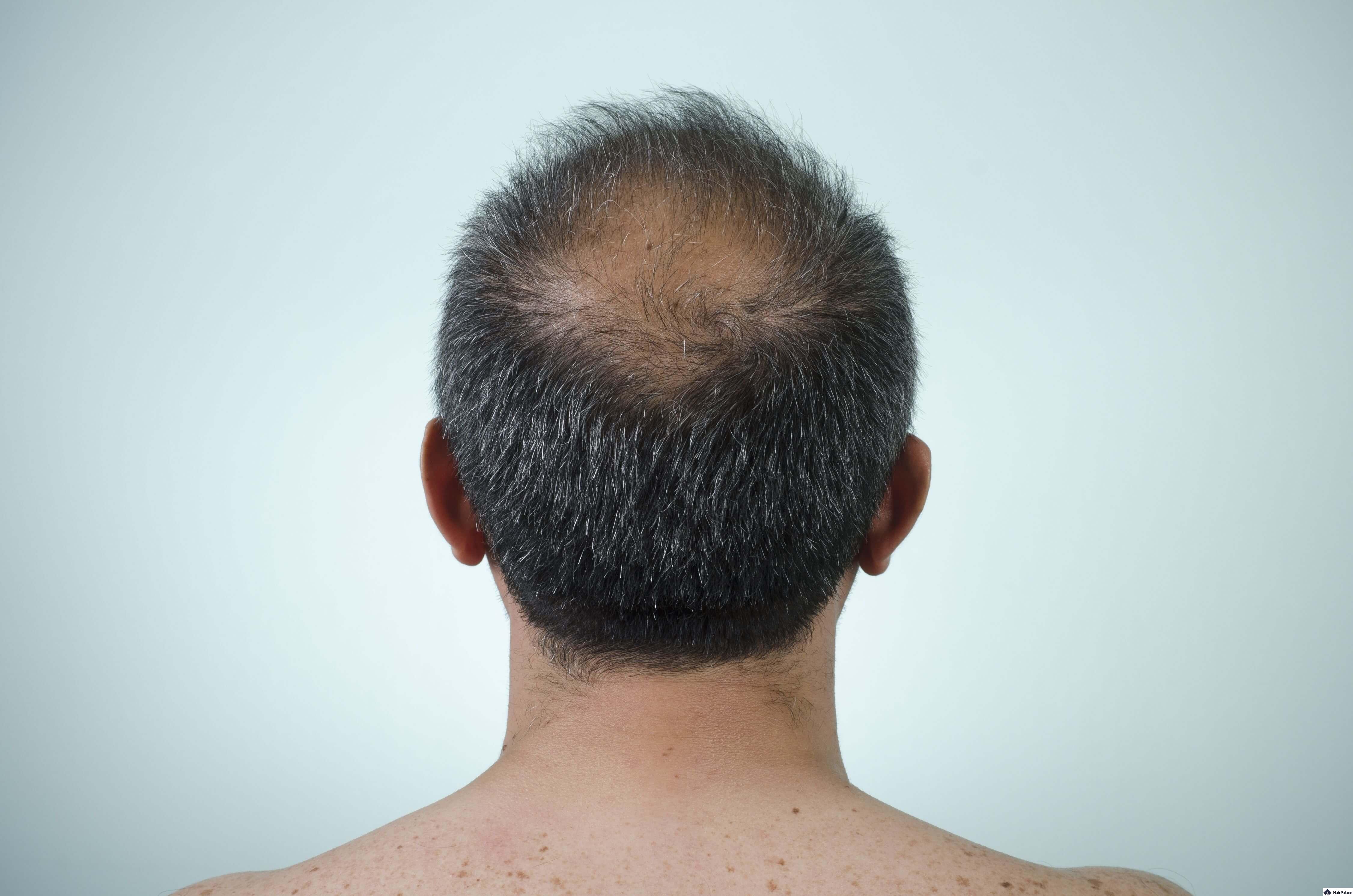
Experiencing baldness at the hair crown, or top of the head is something that millions of men go through all across the world.
Crown hair transplant surgery may be performed on the crown to prevent the patient from going completely bald.
This article will tell you everything there is to know about this procedure!
- What is the crown?
- Hair crown balding causes and symptoms
- Does a crown hair transplant work?
- When is the best time for a hair transplant on the crown?
- Crown hair transplant UK cost
- Best crown hair transplant results
- Crown hair transplant timeline
- How to treat and prevent hair loss on the crown
- Conclusion
What is the crown?
The crown area also referred to as the “vertex” can be found on the highest point on top of your head.
Hair care for men is essential for maintaining your crown area, as it is vulnerable to environmental factors and daily styling.
The hair in the crown, gathered around your mid-scalp in a circular pattern is referred to as the hair whorl.
In fact, some people have two hair whorls, this is also known as a double crown. However, this is completely natural.
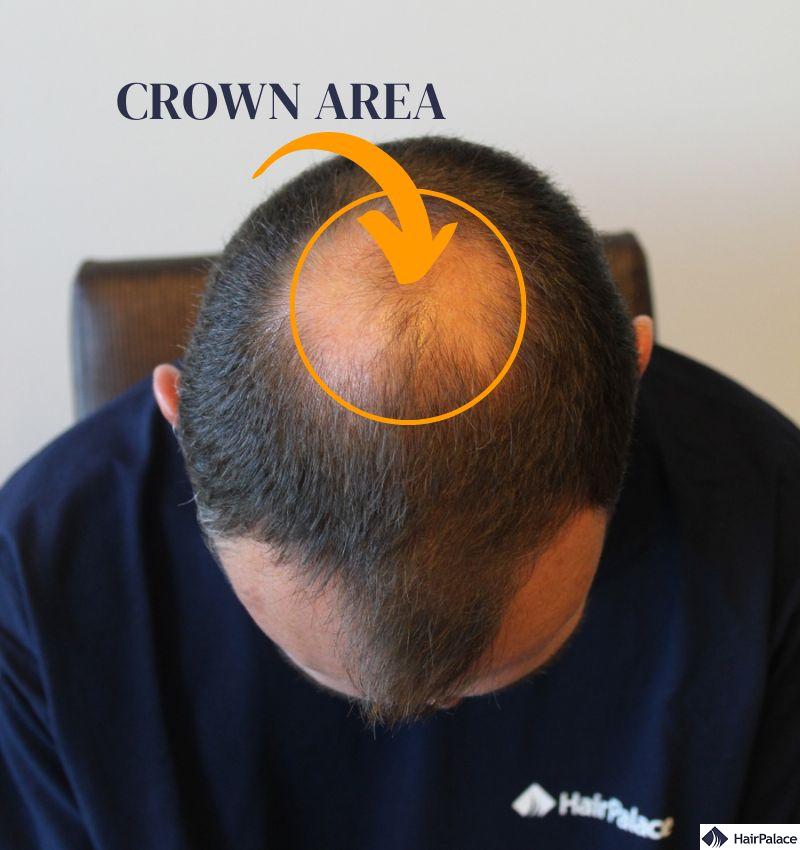
Challenges associated with a hair transplant on the crown
Hair loss on the crown is different from balding on the front.
The underlying process, male pattern baldness, occurs the same way on the crown as it does on the front.
However, there are minor differences in the way you lose hair in these areas.
You usually look at the crown area from a steep angle, which means you usually look down on to it vertically.
This always results in seeing more of the scalp, especially when it comes to someone with darker hair and light skin.
Hair crown balding causes and symptoms
A bald spot on crown can be a cause for concern for many people.
It can be caused by a variety of conditions such as:
- male pattern hair loss
- nutritional deficiencies
- stress
If you’re worried about thinning hair at the crown, the first step is to determine if the thinning is actually occurring.
The symptoms of hair loss include:
- scalp becoming more visible at the crown area
- receding hairline
- finer hairs on other areas of your head
- part line is wider than usual
- hair at the crown is more prone to breakage than the rest of your hair
You may want to talk to your doctor or dermatologist if you are experiencing further hair loss or if you’re considering crown hair transplantation in general.
They can help you determine the cause of the thinning and recommend ways to prevent further hair loss or a crown hair loss treatment.
Does a crown hair transplant work?
A hair transplant operation is the best treatment for crown hair loss, due to both the stunning results and high success rates.
A crown hair transplant is a type of surgical procedure that restores hair growth in the crown (vertex) region of the scalp where hair loss has occurred.
This hair crown transplant procedure involves taking healthy hair follicles from the donor area (usually at the back or sides of the head) and transplanting them into the area of the scalp that is bald or thinning.
Watch Dr Gary Linkov perform a hair transplant on crown while telling you important details about the procedure.
When is the best time for a hair transplant on the crown?
To avoid having a circular pattern of bald skin around the transplanted hair it is generally advised to avoid crown hair restoration if you’re still in your twenties.
This is because you are most likely going to lose more hair in the crown region, which may ruin the results of your crown area hair transplant.
Skilled hair transplant surgeons will always advise against a crown hair transplant when it comes to younger patients.
Generally, it’s advised to try medical treatments for early crown hair loss rather than undergoing a hair transplant prematurely.
Crown hair transplant UK cost
Your crown hair transplant cost will always depend on the size of your crown and the number of hair grafts needed to achieve proper coverage.
Your treatment may range from £3000 to £10000 and you may need more than one procedure to provide coverage for the whole area.
| UK | Ireland | Turkey | USA | Hungary | |
|---|---|---|---|---|---|
| Biggest Package Price | £7779 | £11,040 | £2800 | £10397 | £2499 |
Best crown hair transplant results
Take a look at these amazing crown hair transplant results and see the stunning change for yourself.
Crown hair transplant timeline
We’ll answer one of the most common questions by patients “What to do after hair transplant surgery”? Let’s see what you can expect after the procedure.
1. Day 0-14
During the first two weeks after your hair transplant, you may see some redness in the recipient and donor areas.
You may also experience something called shock loss, which can be scary but it is a perfectly normal part of recovery after the procedure.
You should avoid cutting or rubbing your hair in the first few months as it may lead to losing hair and ruining your crown transplant.
It’s important to stay patient as your crown area hair transplant results will take several months to take shape.
Until then, follow your clinic’s guidelines on how to maintain healthy hair after your transplant.
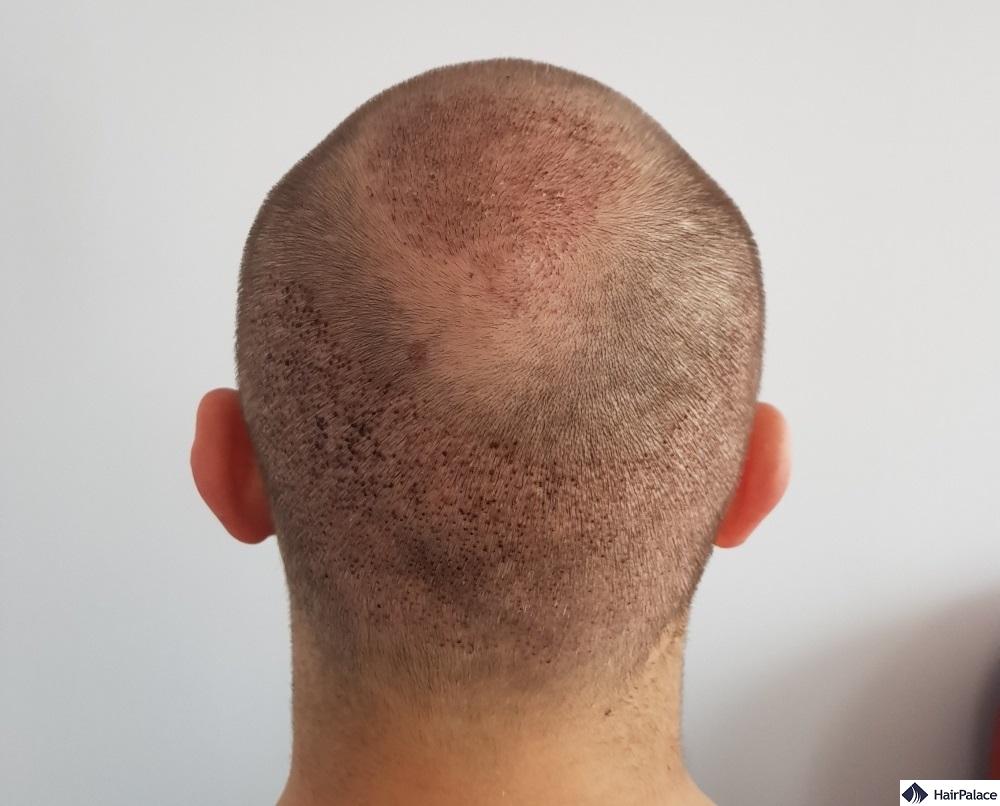
2. Month 3
The implanted hairs will fall out, so 3 months after your surgery the crown area will look almost the same as before.
You may even feel as if your hair thinning has gotten worse.
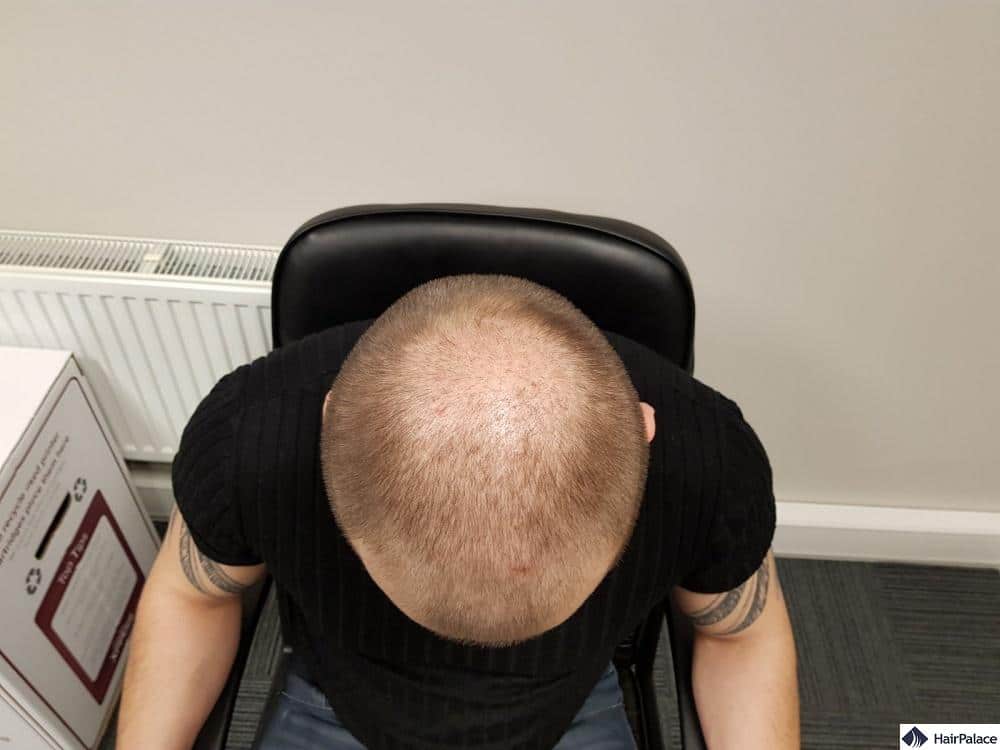
3. Month 4-6
After about 4 months after the hair transplant, you should see your new hairs begin to grow.
Around the 6 month mark, you can expect a considerable amount of growth as your hair grafts have had time to produce new hairs.
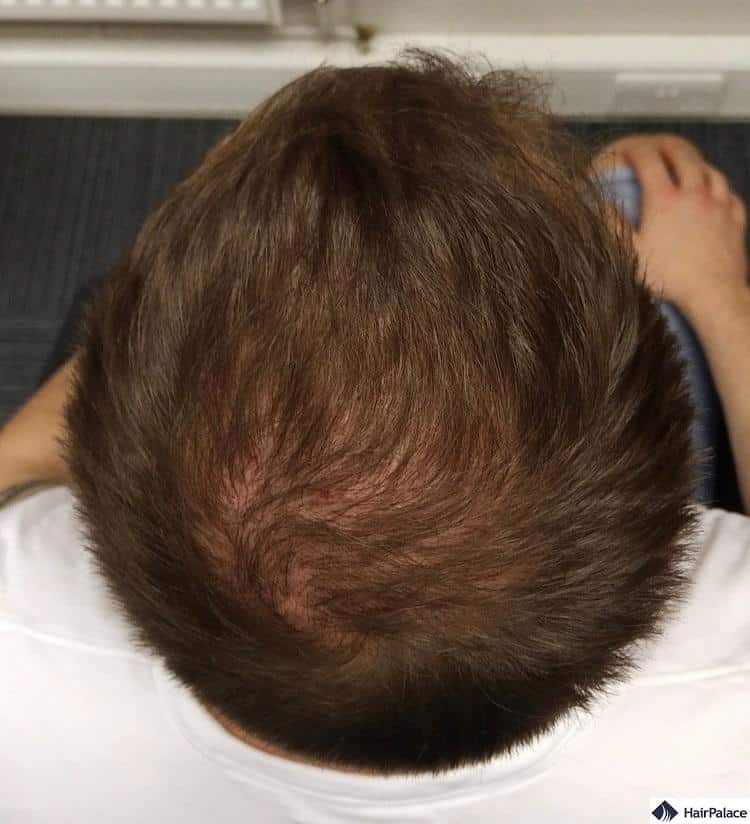
4. Month 12
Finally, around 12-15 months after a FUT or FUE hair transplant on the crown, most of the hair implanted by your hair transplant surgeon will have had time to emerge from your scalp.
By the end of this period you can finally enjoy the full extent of your results.
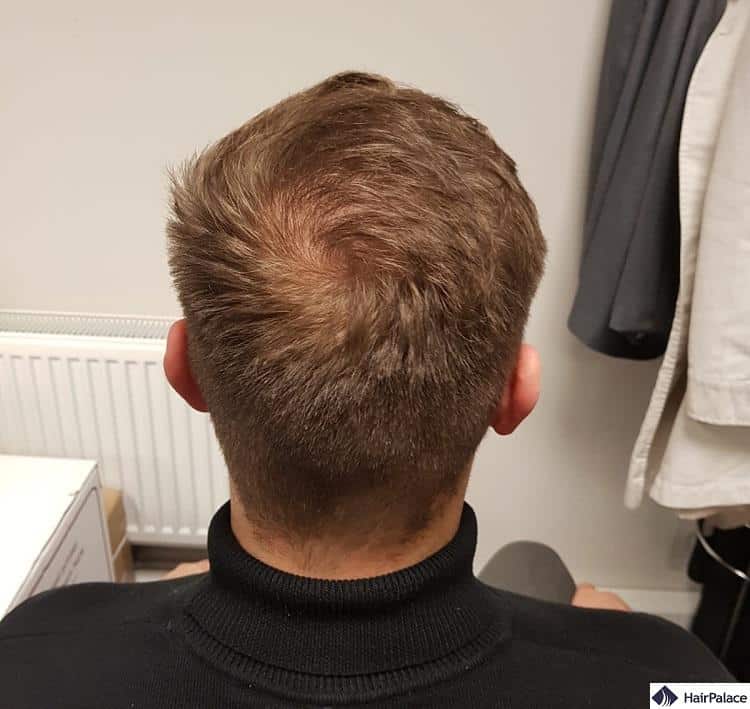
How to treat and prevent hair loss on the crown
Hair loss in the mid-scalp area can be frustrating to deal with.
The condition may have a significant impact on your appearance and self-confidence. Thankfully, there are several steps you can take.
First, you should identify the underlying cause of your crown vertex hair loss.
The most common causes include hormonal imbalances, hereditary hair loss, and side effects from medications.
A hair transplant surgeon can determine why you’re losing more hair than usual, and provide a treatment plan.
It is also important to establish healthy hair habits. This should entail using the right conditioner, and the best shampoo for hair loss.
You should also limit the use of heat-styling tools and hair products containing heavy chemicals.
Additionally, regular scalp massages can also improve the health of your scalp.
You should also make sure to include enough vitamins and minerals in your diet if you aim to maintain healthy hair growth.
Vitamins such as iron, zinc, and vitamin B all help to promote hair growth. Vitamin supplements, such as Nutrafol may also be beneficial.
Additionally, you can also try essential oils for hair growth, extracts such as rosemary oil have been shown to promote healthier hair.
Finally, if all else fails, you should consider hair loss medication or hair transplant surgery to treat your thinning hair.
A doctor can help you choose the right treatment suited to your personal needs.
űIf you follow these tips and work together with a healthcare professional, you can successfully treat and limit future hair loss.
With the right treatment plan, you can regain both your confidence and your hair.
Conclusion
These procedures always come with certain risks as this area is a moving target that evolves through the years.
The number of grafts needed, the nature of androgenic alopecia along with the unusual hair growth that occurs in the region, all increase the difficulty of having a successful hair transplant on the crown.
If you think you’re losing hair at the crown at an abnormal rate it’s best to sign up for a free consultation with the clinic of your choice to geta diagnosis and an appropriate treatment plan.
This will allow you to ask all the questions you have about the procedure, and get a better idea of what you can expect.
Hair Transplant on The Crown FAQ
You should sleep in an elevated position to reduce the swelling in your scalp and forehead and speed up the healing process. Try to avoid turning or rubbing your crown against the pillow. You could also lay on your side to minimize friction.
Yes, the crown is notorious for slower hair growth. People often notice hair loss on the crown later than they do in areas that are more visible on a day-to-day basis. This usually means that they are also slower to cure hair loss, which can impede crown hair regeneration.
The cost of your hair transplant will depend on the size of your crown and the number of hair grafts needed to achieve proper coverage. Costs may range from £3000 to £10000 and you may need more than one procedure to provide coverage for the whole area.
The number of hair grafts needed for the crown area varies greatly depending on the extent of hair loss, but it can range from 1,000 to 3,000 grafts or more.
Crown hair loss is often due to male pattern baldness, which is a genetic condition. Other factors can include stress, poor diet, certain medical conditions, and medications.
If you notice thinning or a bald spot forming at the top of your head, you may be experiencing hair loss on your crown, which is common in male pattern baldness. However, only a personal examination or consultation with a healthcare professional can confirm this.
Regrowth of crown hair depends on the cause of hair loss. If it’s due to temporary factors like stress or nutrition, it can regrow. In cases of male pattern baldness, treatment options like minoxidil, finasteride, or hair transplants may help, but regrowth is not guaranteed.
Yes, a hair transplant is the best way to address hair loss in the crown area and restore the lost hair.
Yes, for many people, hair can be naturally thinner at the crown due to the hair growth cycle and the way hair density varies across the scalp.
Hair transplants work well on the crown. However, this area may require more grafts for full coverage and can be more challenging to achieve natural-looking results compared to the hairline.
Last medically reviewed on October 8th, 2024
- Ayres S 3rd. Hair transplantation for male pattern baldness: aesthetic considerations and current status. Head Neck Surg. 1985 Mar-Apr;7(4):272-85. doi: 10.1002/hed.2890070404. PMID: 3988532.https://pubmed.ncbi.nlm.nih.gov/3988532/
- Devroye J. Management of the crown. Facial Plast Surg Clin North Am. 2013 Aug;21(3):397-406. doi: 10.1016/j.fsc.2013.06.005. PMID: 24017981.https://pubmed.ncbi.nlm.nih.gov/24017981/
- Dardour JC. Treatment of male pattern baldness and postoperative temporal baldness in men. Clin Plast Surg. 1991 Oct;18(4):775-90. PMID: 1934891.https://pubmed.ncbi.nlm.nih.gov/1934891/
- Rose PT. Advances in Hair Restoration. Dermatol Clin. 2018 Jan;36(1):57-62. doi: 10.1016/j.det.2017.09.008. PMID: 29108547.https://pubmed.ncbi.nlm.nih.gov/29108547/








